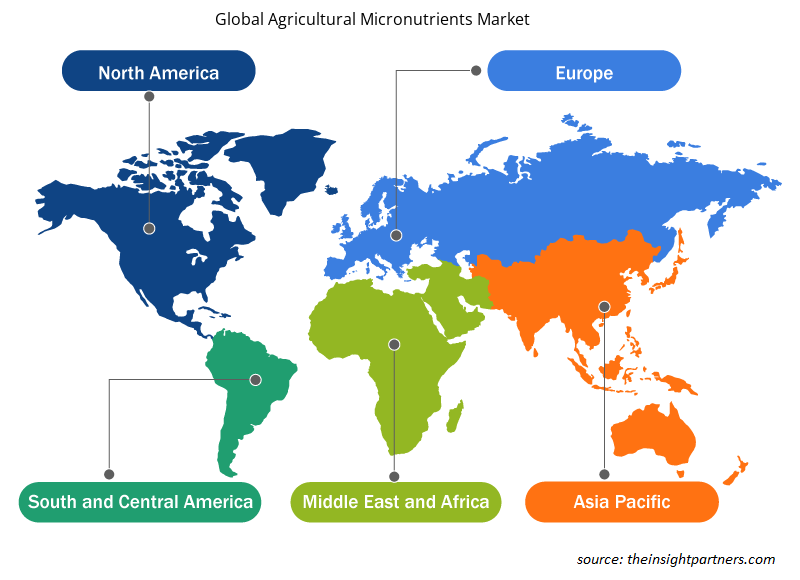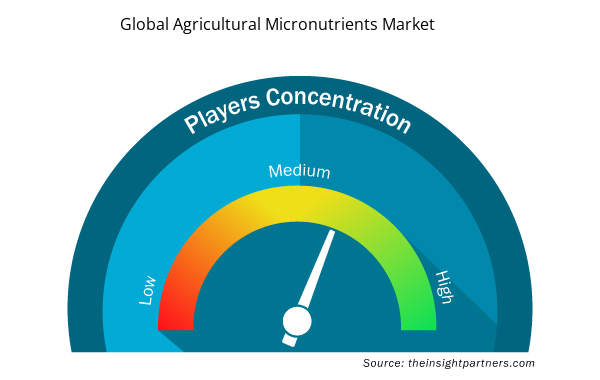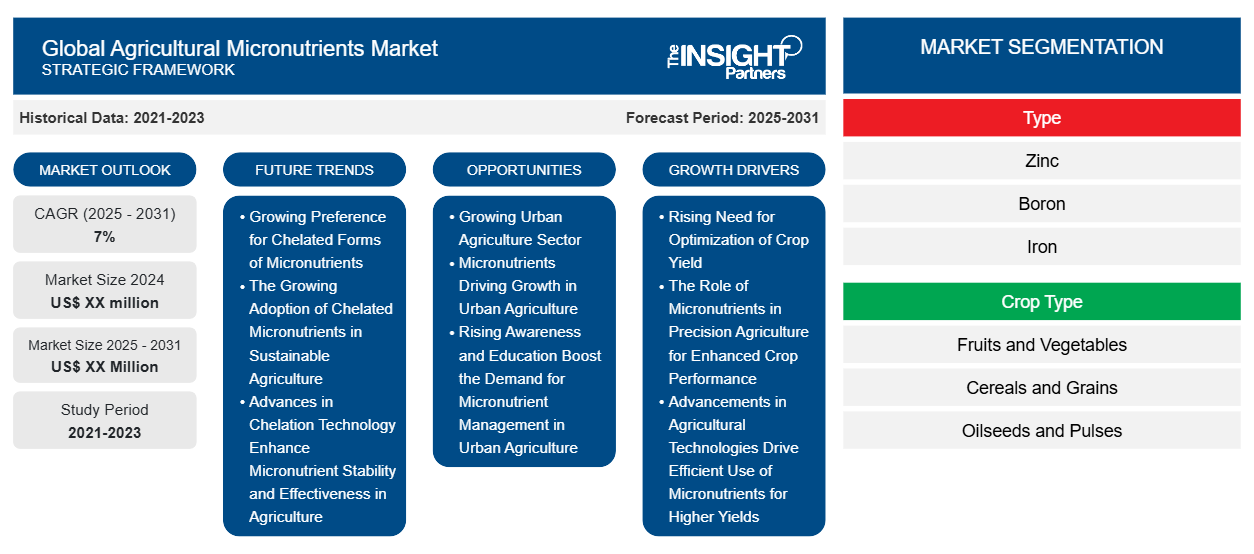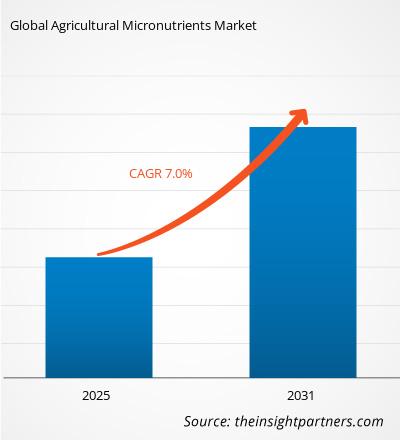Se espera que el mercado de micronutrientes agrícolas registre una CAGR del 7% entre 2023 y 2031, con un tamaño de mercado que se expandirá de US$ XX millones en 2023 a US$ XX millones en 2031.
El informe está segmentado por tipo (zinc, boro, hierro, molibdeno, cobre, manganeso y otros). El informe presenta además un análisis basado en el tipo de cultivo (frutas y verduras, cereales y granos, semillas oleaginosas y legumbres, y otros). El informe basado en la forma está segmentado en (quelado y no quelado). El informe basado en el modo de aplicación está segmentado en (suelo, foliar, fertirrigación y otros). El análisis global se desglosa aún más a nivel regional y por países principales. El informe ofrece el valor en USD para el análisis y los segmentos anteriores.
Propósito del Informe
El informe Agricultural Micronutrients Market de The Insight Partners tiene como objetivo describir el panorama actual y el crecimiento futuro, los principales factores impulsores, los desafíos y las oportunidades. Esto proporcionará información a diversas partes interesadas del negocio, como:
- Proveedores/fabricantes de tecnología: Para comprender la dinámica cambiante del mercado y conocer las oportunidades potenciales de crecimiento, lo que les permitirá tomar decisiones estratégicas informadas.
- Inversionistas: Realizar un análisis exhaustivo de tendencias sobre la tasa de crecimiento del mercado, las proyecciones financieras del mercado y las oportunidades que existen en toda la cadena de valor.
- Órganos reguladores: Regular las políticas y vigilar las actividades del mercado con el objetivo de minimizar los abusos, preservar la confianza de los inversores y defender la integridad y estabilidad del mercado.
Segmentación del mercado de micronutrientes agrícolas
Tipo
- Zinc
- Boro
- Hierro
- Molibdeno
- Cobre
- Manganeso
Tipo de cultivo
- Frutas y verduras
- Cereales y Granos
- Semillas oleaginosas y legumbres
Forma
- Quelado y no quelado
Geografía
- América del norte
- Europa
- Asia-Pacífico
- América del Sur y Central
- Oriente Medio y África
Geografía
- América del norte
- Europa
- Asia-Pacífico
- América del Sur y Central
- Oriente Medio y África
Personalice este informe según sus necesidades
Obtendrá personalización en cualquier informe, sin cargo, incluidas partes de este informe o análisis a nivel de país, paquete de datos de Excel, así como también grandes ofertas y descuentos para empresas emergentes y universidades.
- Obtenga las principales tendencias clave del mercado de este informe.Esta muestra GRATUITA incluirá análisis de datos, desde tendencias del mercado hasta estimaciones y pronósticos.
Factores impulsores del crecimiento del mercado de micronutrientes agrícolas
- Necesidad creciente de optimizar el rendimiento de los cultivos: uno de los enormes impactos que se le otorgará al mercado de micronutrientes agrícolas es el aumento de la optimización del rendimiento. Esto se deberá a la tendencia de los agricultores a mejorar la productividad y la calidad de los cultivos, lo que conducirá a una mayor demanda de micronutrientes como el zinc, el hierro y el manganeso. Este ha sido uno de los componentes críticos de la salud y el rendimiento de las plantas, en particular en condiciones ambientales adversas.
- El papel de los micronutrientes en la agricultura de precisión para mejorar el rendimiento de los cultivos: Con el rápido crecimiento de la población surge la necesidad de optimizar la producción agrícola, junto con la inseguridad alimentaria. Para cerrar las brechas de deficiencias en elementos que de otro modo limitarían el rendimiento de los cultivos, los agricultores están introduciendo cada vez más fertilizantes y enmiendas del suelo en el campo. Este enfoque en la agricultura de precisión aumenta aún más la conciencia sobre el papel de los micronutrientes en la práctica sostenible de la agricultura.
- Los avances en las tecnologías agrícolas impulsan el uso eficiente de micronutrientes para lograr mayores rendimientos: de manera similar, la alta intensidad de aplicación de micronutrientes también proviene de las tecnologías agrícolas. Con sistemas mejorados de análisis de suelos y manejo de nutrientes, los agricultores generalmente pueden aumentar sus insumos con mayor cuidado, no solo para obtener rendimientos más remunerativos sino también para un uso más económico de los recursos que asegure una mayor rentabilidad en las operaciones agrícolas.
Tendencias futuras del mercado de micronutrientes agrícolas
- Creciente preferencia por las formas queladas de micronutrientes: Una de las nuevas tendencias en micronutrientes agrícolas es la creciente demanda de formas queladas de micronutrientes. Los micronutrientes quelados son micronutrientes quelados a moléculas orgánicas, que ofrecen mayor biodisponibilidad que las formas tradicionales y, por lo tanto, mayor absorción por las plantas y mejor rendimiento de los cultivos.
- La creciente adopción de micronutrientes quelados en la agricultura sostenible: otro beneficio de las aplicaciones de micronutrientes quelados que han descubierto los agricultores es la corrección específica de deficiencias de nutrientes específicos en los suelos. A medida que aumenta la conciencia ambiental hacia la gestión de nutrientes, cada vez más agricultores adoptan estas formas con facilidad como un modo de mejorar la salud y el rendimiento de las plantas. Esta tendencia coincide con el llamamiento que se ha hecho a todas las naciones del mundo para que adopten una agricultura sostenible.
- Los avances en la tecnología de quelación mejoran la estabilidad y la eficacia de los micronutrientes en la agricultura: avances en la tecnología de quelación de otros impulsores. Realización de nuevas mejoras en la forma en que se formulan los micronutrientes quelados para lograr una mayor estabilidad y, por lo tanto, una mayor eficacia. Estas nuevas formulaciones de micronutrientes quelados facilitan su aplicación y, por lo tanto, dan mejores resultados, lo que obliga a una adopción más amplia y más sistémica en los sectores agrícolas.
Oportunidades de mercado para los micronutrientes agrícolas
- Crecimiento del sector de la agricultura urbana: De hecho, el creciente sector de la agricultura urbana es una fuente muy considerable de crecimiento para el mercado de micronutrientes agrícolas. A medida que la dependencia del cultivo de alimentos en las ciudades avanza como una forma esencial de satisfacer las demandas alimentarias, la gestión de nutrientes es cada vez más importante. Los micronutrientes desempeñan un papel vital en el impulso de la productividad de estos sistemas agrícolas compactos.
- Los micronutrientes impulsan el crecimiento de la agricultura urbana: las nuevas ideas en este ámbito son la agricultura vertical y la hidroponía, que no pueden funcionar sin nutrientes formulados con precisión. Son los micronutrientes los que maximizarán el crecimiento de las plantas en entornos controlados, como la agricultura urbana. Los agricultores urbanos utilizan estos micronutrientes para lograr mayores rendimientos en espacios pequeños y estrechos. Estos productos con micronutrientes son cada vez más buscados para su uso en entornos agrícolas urbanos.
- La creciente concienciación y la educación impulsan la demanda de gestión de micronutrientes en la agricultura urbana: la mayor conciencia pública sobre los programas de educación y formación en las ciudades también genera una mayor demanda de concienciación sobre la gestión de nutrientes. El aumento de la concienciación sobre los beneficios de los micronutrientes en la agricultura urbana contribuye a la creciente tendencia de dichos productos. Por lo tanto, esto seguirá haciendo crecer el mercado de micronutrientes agrícolas a medida que la tendencia de la agricultura urbana siga creciendo.
Perspectivas regionales del mercado mundial de micronutrientes agrícolas
Los analistas de Insight Partners explicaron en detalle las tendencias y los factores regionales que influyen en el mercado global de micronutrientes agrícolas durante el período de pronóstico. Esta sección también analiza los segmentos y la geografía del mercado global de micronutrientes agrícolas en América del Norte, Europa, Asia Pacífico, Oriente Medio y África, y América del Sur y Central.

- Obtenga datos regionales específicos para el mercado mundial de micronutrientes agrícolas
Alcance del informe sobre el mercado mundial de micronutrientes agrícolas
| Atributo del informe | Detalles |
|---|---|
| Tamaño del mercado en 2023 | XX millones de dólares estadounidenses |
| Tamaño del mercado en 2031 | US$ XX millones |
| CAGR global (2023 - 2031) | 7% |
| Datos históricos | 2021-2022 |
| Período de pronóstico | 2024-2031 |
| Segmentos cubiertos | Por tipo
|
| Regiones y países cubiertos | América del norte
|
| Líderes del mercado y perfiles de empresas clave |
|
Densidad de actores del mercado mundial de micronutrientes agrícolas: comprensión de su impacto en la dinámica empresarial
El mercado mundial de micronutrientes agrícolas está creciendo rápidamente, impulsado por la creciente demanda de los usuarios finales debido a factores como la evolución de las preferencias de los consumidores, los avances tecnológicos y una mayor conciencia de los beneficios del producto. A medida que aumenta la demanda, las empresas amplían sus ofertas, innovan para satisfacer las necesidades de los consumidores y aprovechan las tendencias emergentes, lo que impulsa aún más el crecimiento del mercado.
La densidad de actores del mercado se refiere a la distribución de las empresas o firmas que operan dentro de un mercado o industria en particular. Indica cuántos competidores (actores del mercado) están presentes en un espacio de mercado determinado en relación con su tamaño o valor total de mercado.
Las principales empresas que operan en el mercado mundial de micronutrientes agrícolas son:
- BASF SE
- Coromandel International Limited
- Nutrien Ltd.
- La empresa Mosaic
- Grupo Haifa
Descargo de responsabilidad : Las empresas enumeradas anteriormente no están clasificadas en ningún orden particular.

- Obtenga una descripción general de los principales actores clave del mercado global de micronutrientes agrícolas
Puntos de venta clave
- Cobertura integral: el informe cubre de manera integral el análisis de productos, servicios, tipos y usuarios finales del mercado de micronutrientes agrícolas, proporcionando un panorama holístico.
- Análisis de expertos: el informe se compila sobre la base de un profundo conocimiento de expertos y analistas de la industria.
- Información actualizada: El informe asegura relevancia comercial debido a su cobertura de información reciente y tendencias de datos.
- Opciones de personalización: este informe se puede personalizar para satisfacer los requisitos específicos del cliente y adaptarse adecuadamente a las estrategias comerciales.
Por lo tanto, el informe de investigación sobre el mercado de micronutrientes agrícolas puede ayudar a abrir camino para descifrar y comprender el escenario de la industria y las perspectivas de crecimiento. Si bien puede haber algunas preocupaciones válidas, los beneficios generales de este informe tienden a superar las desventajas.
- Análisis histórico (2 años), año base, pronóstico (7 años) con CAGR
- Análisis PEST y FODA
- Tamaño del mercado Valor/volumen: global, regional, nacional
- Industria y panorama competitivo
- Conjunto de datos de Excel


- Skin Tightening Market
- Health Economics and Outcome Research (HEOR) Services Market
- Photo Editing Software Market
- Medical and Research Grade Collagen Market
- Organoids Market
- Biopharmaceutical Contract Manufacturing Market
- Animal Genetics Market
- Online Recruitment Market
- Railway Braking System Market
- Antibiotics Market

Report Coverage
Revenue forecast, Company Analysis, Industry landscape, Growth factors, and Trends

Segment Covered
This text is related
to segments covered.

Regional Scope
North America, Europe, Asia Pacific, Middle East & Africa, South & Central America

Country Scope
This text is related
to country scope.
Preguntas frecuentes
Growing Preference for Chelated Forms of Micronutrients is expected to be the key market trends.
Based on geography, Asia Pacific held the largest share of the agricultural micronutrients market.
Based on type, zinc, is expected to witness the fastest growth during the forecast period
BASF SE, Coromandel International Limited, Nutrien Ltd are some of the key players operating in the agricultural micronutrients market
Rising Need for Optimization of Crop Yield is driving the market growth
The Agricultural Micronutrients Market is estimated to witness a CAGR of 7% from 2023 to 2031
Trends and growth analysis reports related to Chemicals and Materials : READ MORE..
The List of Companies
1. BASF SE
2. Coromandel International Limited
3. Nutrien Ltd.
4. The Mosaic Company
5. Haifa Group
6. Yara International ASA
7. Helena Agri-Enterprises LLC
8. Valagro S.p.A
9. Sigma AgriScience, LLC
10. Aries Agro Limited
11. Nufarm Limited
12. AgroLiquid
13. Agrium
14. Akzonobel
15. Dow Chemical
16. ADAMA Agricultural Solutions Ltd.
17. Agrium Inc.
18. Akzo Nobel N.V.
19. Auriga Industries A/S
20.Bayer Crop.
The Insight Partners performs research in 4 major stages: Data Collection & Secondary Research, Primary Research, Data Analysis and Data Triangulation & Final Review.
- Data Collection and Secondary Research:
As a market research and consulting firm operating from a decade, we have published and advised several client across the globe. First step for any study will start with an assessment of currently available data and insights from existing reports. Further, historical and current market information is collected from Investor Presentations, Annual Reports, SEC Filings, etc., and other information related to company’s performance and market positioning are gathered from Paid Databases (Factiva, Hoovers, and Reuters) and various other publications available in public domain.
Several associations trade associates, technical forums, institutes, societies and organization are accessed to gain technical as well as market related insights through their publications such as research papers, blogs and press releases related to the studies are referred to get cues about the market. Further, white papers, journals, magazines, and other news articles published in last 3 years are scrutinized and analyzed to understand the current market trends.
- Primary Research:
The primarily interview analysis comprise of data obtained from industry participants interview and answers to survey questions gathered by in-house primary team.
For primary research, interviews are conducted with industry experts/CEOs/Marketing Managers/VPs/Subject Matter Experts from both demand and supply side to get a 360-degree view of the market. The primary team conducts several interviews based on the complexity of the markets to understand the various market trends and dynamics which makes research more credible and precise.
A typical research interview fulfils the following functions:
- Provides first-hand information on the market size, market trends, growth trends, competitive landscape, and outlook
- Validates and strengthens in-house secondary research findings
- Develops the analysis team’s expertise and market understanding
Primary research involves email interactions and telephone interviews for each market, category, segment, and sub-segment across geographies. The participants who typically take part in such a process include, but are not limited to:
- Industry participants: VPs, business development managers, market intelligence managers and national sales managers
- Outside experts: Valuation experts, research analysts and key opinion leaders specializing in the electronics and semiconductor industry.
Below is the breakup of our primary respondents by company, designation, and region:

Once we receive the confirmation from primary research sources or primary respondents, we finalize the base year market estimation and forecast the data as per the macroeconomic and microeconomic factors assessed during data collection.
- Data Analysis:
Once data is validated through both secondary as well as primary respondents, we finalize the market estimations by hypothesis formulation and factor analysis at regional and country level.
- Macro-Economic Factor Analysis:
We analyse macroeconomic indicators such the gross domestic product (GDP), increase in the demand for goods and services across industries, technological advancement, regional economic growth, governmental policies, the influence of COVID-19, PEST analysis, and other aspects. This analysis aids in setting benchmarks for various nations/regions and approximating market splits. Additionally, the general trend of the aforementioned components aid in determining the market's development possibilities.
- Country Level Data:
Various factors that are especially aligned to the country are taken into account to determine the market size for a certain area and country, including the presence of vendors, such as headquarters and offices, the country's GDP, demand patterns, and industry growth. To comprehend the market dynamics for the nation, a number of growth variables, inhibitors, application areas, and current market trends are researched. The aforementioned elements aid in determining the country's overall market's growth potential.
- Company Profile:
The “Table of Contents” is formulated by listing and analyzing more than 25 - 30 companies operating in the market ecosystem across geographies. However, we profile only 10 companies as a standard practice in our syndicate reports. These 10 companies comprise leading, emerging, and regional players. Nonetheless, our analysis is not restricted to the 10 listed companies, we also analyze other companies present in the market to develop a holistic view and understand the prevailing trends. The “Company Profiles” section in the report covers key facts, business description, products & services, financial information, SWOT analysis, and key developments. The financial information presented is extracted from the annual reports and official documents of the publicly listed companies. Upon collecting the information for the sections of respective companies, we verify them via various primary sources and then compile the data in respective company profiles. The company level information helps us in deriving the base number as well as in forecasting the market size.
- Developing Base Number:
Aggregation of sales statistics (2020-2022) and macro-economic factor, and other secondary and primary research insights are utilized to arrive at base number and related market shares for 2022. The data gaps are identified in this step and relevant market data is analyzed, collected from paid primary interviews or databases. On finalizing the base year market size, forecasts are developed on the basis of macro-economic, industry and market growth factors and company level analysis.
- Data Triangulation and Final Review:
The market findings and base year market size calculations are validated from supply as well as demand side. Demand side validations are based on macro-economic factor analysis and benchmarks for respective regions and countries. In case of supply side validations, revenues of major companies are estimated (in case not available) based on industry benchmark, approximate number of employees, product portfolio, and primary interviews revenues are gathered. Further revenue from target product/service segment is assessed to avoid overshooting of market statistics. In case of heavy deviations between supply and demand side values, all thes steps are repeated to achieve synchronization.
We follow an iterative model, wherein we share our research findings with Subject Matter Experts (SME’s) and Key Opinion Leaders (KOLs) until consensus view of the market is not formulated – this model negates any drastic deviation in the opinions of experts. Only validated and universally acceptable research findings are quoted in our reports.
We have important check points that we use to validate our research findings – which we call – data triangulation, where we validate the information, we generate from secondary sources with primary interviews and then we re-validate with our internal data bases and Subject matter experts. This comprehensive model enables us to deliver high quality, reliable data in shortest possible time.


 Obtenga una muestra gratuita de este informe
Obtenga una muestra gratuita de este informe